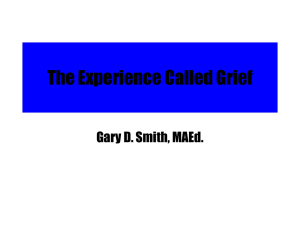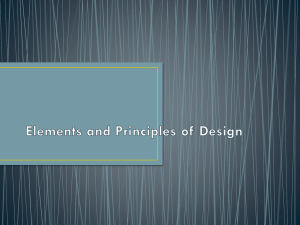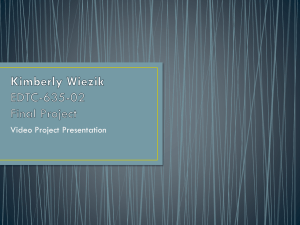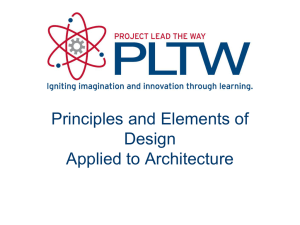U6 Elements and Principles of Design - Wikispaces
advertisement
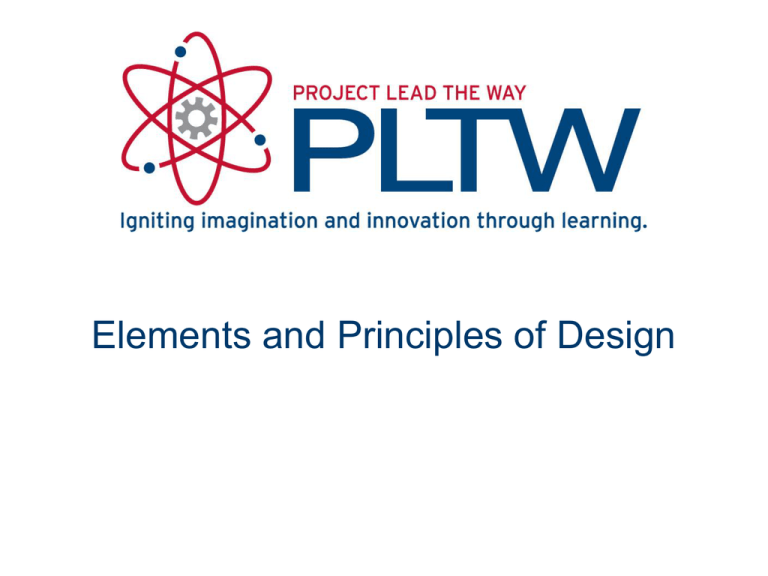
Elements and Principles of Design Visual Design Elements Eight integral components used in the creation of a design: •Point •Shape •Line •Form •Color •Space •Value •Texture Point • Most basic element of design • Has position but no dimension • Can be described by coordinates on a plane • Used to indicate a location Image courtesy Autodesk, Inc. Image courtesy Autodesk, Inc. Line • Has only a length dimension • Can be used to – – – – – – Image courtesy Autodesk, Inc. Define a boundary Indicate volume Create perspective and depth Create textures and patterns Suggest movement Imply emotion Microsoft Office clipart Image courtesy Autodesk, Inc. Microsoft Office clipart Line Types • Vertical - Represents dignity, formality, stability, and strength • Horizontal - Represents calm, peace, and relaxation • Diagonal - Represents action, activity, excitement, and movement • Curved - Represents freedom, the natural, having the appearance of softness, and creates a soothing feeling or mood Vertical Lines • Vertical lines characterize dignity, formality, stability, and strength The Empire State Building Architect: Shreve, Lamb, and Harmon Microsoft Office clipart Brandenburg Gate Berlin Skyscraper Madrid, Spain Horizontal Lines Microsoft Office clipart • Horizontal lines represent calm, peace, and relaxation Wikimedia.org Community Christian Church Kansas City, MO Architect: Frank Lloyd Wright, 1940 Diagonal Lines Microsoft Office clipart • Diagonal lines give the sense of movement, action, and activity. ©iStockphoto.com Microsoft Office clipart Curved Lines Microsoft Office clipart ©iStockphoto.com ©iStockphoto.com Microsoft Office clipart • Curved lines give the sense of freedom and a soothing mood Sydney Opera House Jorn Utzon Color Described by a number of qualities – Hue: base color (e.g., red) – Value: lightness or darkness – Saturation: purity or intensity relative to gray Color Temperature Image courtesy Autodesk, Inc. Cool Colors Blues, purples, greens Warm Colors Reds, oranges, yellows Color • Color has an immediate and profound effect on a design Microsoft Office clipart Microsoft Office clipart Value • Relative lightness or darkness of a color, object, or shape Microsoft Office clipart Value • Allows us to perceive shapes and the illusion of 3D objects on a 2D surface Image courtesy Autodesk, Inc. Shape • A 2D area enclosed by lines or curves • Types – Geometric: square, circle, triangle – Mechanical: simple shapes made of straight and curved lines – Organic: natural or simulating nature Microsoft clipart Image courtesy Autodesk, Inc. Geometric Mechanical Image courtesy Autodesk, Inc. Organic Shape Form • A 3D volume or solid • Often implied on a 2D surface by careful use of value Image courtesy Autodesk, Inc. Form ©iStockphoto.com Microsoft clipart Oriental Pearl Tower Shanghai Architect: Jiang Huan Cheng, Shanghai Modern Architectural Design, Co. Ancient Egyptian Pyramids Space • Areas between and around parts of an image or the implied depth in that image • Types – Positive – Negative ©iStockphoto.com Image courtesy Autodesk, Inc. Space • Evident in images with depth • Types – Open, uncluttered – Cramped, busy Microsoft clipart Texture • The surface look or feel • Types – Smooth • Reflects more light • More intense color – Rough • Absorbs more light • Appears darker Image courtesy Autodesk, Inc. Texture Fluffy Smooth ©iStockphoto.com Rough Exterior metal façade of Disney Concert Hall Los Angeles ©iStockphoto.com Park Guell – Barcelona, Spain Architect: Antonio Gaudí Microsoft clipart Principles of Design • Many principles add to an interesting design •Balance •Proportion •Emphasis •Unity •Contrast •Economy •Rhythm Balance • Visual and physical balance • The distribution of elements within a design • Types – Symmetrical (formal) – Asymmetrical (informal) – Radial Symmetrical (Formal) Balance • The elements within the design are identical in visual weight in relation to a centerline or axis ©iStockphoto.com ©iStockphoto.com The Taj Mahal Mausoleum Agra, Uttar Pradesh, India Microsoft clipart Microsoft Office clipart Asymmetrical (Informal) Balance • The elements within the design are not identical but are arranged to provide a balanced visual weight Image courtesy Autodesk, Inc. Microsoft Office clipart Radial Balance • Distribution of components in a circular pattern around a center point Microsoft Office clipart Dresden Frauenkirche Dresden, Germay Microsoft clipart Emphasis • Used to draw attention to one area • Focal Point – feature in a design that attracts the eye • Can be achieved through – Size – Placement – Shape – Contrast – Use of lines Wikipedia.org Microsoft Office clipart Emphasis Microsoft clipart ©iStockphoto.com Microsoft Office clipart Contrast • The degree of relative difference between elements ©iStockphoto.com Image courtesy Autodesk, Inc. Contrast • Can be used to emphasize an element of a design Image courtesy Autodesk, Inc. Rhythm • Repeated use of line, shape, color, texture or pattern • A harmonious pattern or sequence • Types – Regular – Random – Gradated – Graduated Microsoft Office clipart Regular Rhythm • An element is repeated at the same repetition/interval Microsoft Office clipart Microsoft Office clipart Random Rhythm Microsoft Office clipart • The repetition of the element is random or situated at irregular intervals Microsoft Office clipart Gradated Rhythm • The repeated element is identical with the exception of one detail increasing or decreasing gradually with each repetition Left: Stack of rocks used as focal point in landscaping Right: The Chinese Tower English Gardens Munich, Germany Microsoft Office clipart www.wikimedia.org Microsoft Office clipart Graduated Rhythm • The repeated element becomes closer or further apart Microsoft Office clipart Microsoft Office clipart Proportion Microsoft Office clipart • Comparative relationship between elements in a design with respect to size • Scale – The proportion or size of an element in relation to the other elements Microsoft Office clipart Microsoft Office clipart Unity • The consistent use of design elements ©iStockphoto.com Microsoft Office clipart ©iStockphoto.com Economy • Use of the bare minimum of elements • Can be achieved by removing extraneous elements • In simplicity there is beauty • Less is more Image courtesy Autodesk, Inc. Economy Image courtesy Autodesk, Inc. Image courtesy Autodesk, Inc.
